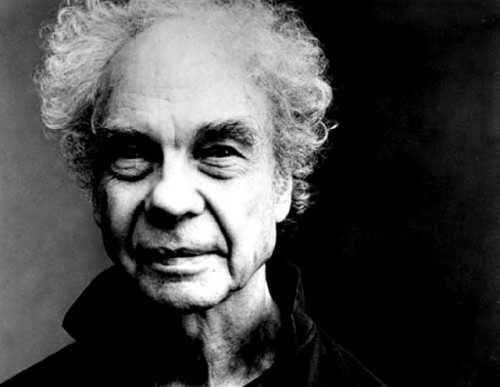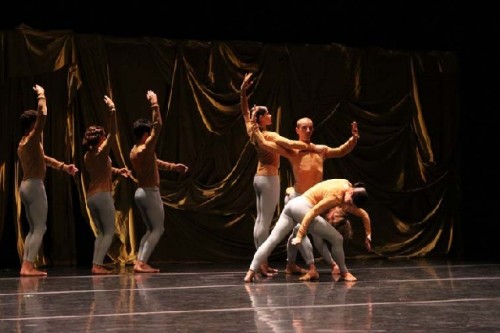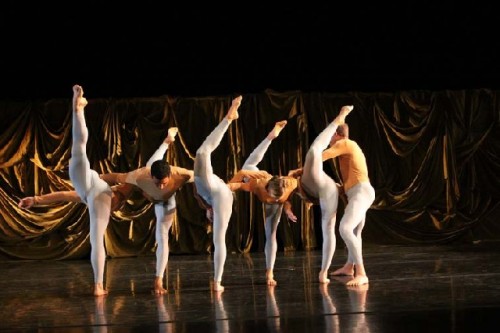Merce Cunningham at Jacob's Pillow
Honoring the Choreographer Who Died at 90
By: Charles Giuliano - Jul 25, 2009
Link to NY Times Obituary, July 27, 2009
Ella Baff, Executive Director of Jacob's Pillow, comments:"Merce: one word that describes a revolution. He performed with Martha Graham, who danced with Ruth St. Denis, partner of Ted Shawn, who founded Jacob's Pillow. He belongs to an unbroken lineage of dance in America . He created something completely new that influenced the world; it was as if dance began again. It was a joy to celebrate his 90th birthday this past week and to honor him earlier this year with the Jacob's Pillow Dance Award. Merce first performed at the Pillow in 1955, and in what feels today like a profound moment of completion, the performances here were the last he saw of his company - our opening night on Wednesday was streamed to him on his laptop. He always lived in the future, and the rest of us followed him there." July 27, 2009
CRWDSPCR (1993)
Dancers: Brandon Collwes, Dylan Crossman, Julie Cunningham (Krista Nilson performed her part), Emma Desjardins, Jennifer Goggans, Daniel Madoff, Rashaun Mitchell, Marcie Munnerlyn, Silas Riener, Jamie Scott, Robert Swinston, Melissa Toogood, Andrea Weber
Music: John King "Blues '99" Fast Forward and Sarah Ibrahim
Décor, Costumes, Lighting: Mark Lancaster
eyeSpace (2006)
Dancers: Brandon Collwes, Dylan Crossman, Julie Cunningham, Emma Desjardins, Jennifer Goggans, Daniel Madoff, Rashaun Mitchell, Marcie Munnerlyn, Silas Riener, Jamie Scott, Melissa Toogood, Andrew Weber
Music: Mikel Rouse "International Cloud Atlas" Fast Forward
Costumes: Henry Samelson
Décor: Henry Samelson "Blues Arrive Not Anticipating What Transpires Even Between Themselves"
Lighting: Josh Johnson
Sounddance (1975)
Dancers: Brandon Collwes, Julie Cunningham, Jennifer Goggans, Daniel Madoff, Rashaun Mitchell, Marcie Munnerlyn, Silas Riener, Jamie Scott, Robert Swinston, Melissa Toogood, Andre Weber
Music: David Tudor "Untitled" 1975/1994, Fast Forward
Décor and Costumes: Mark Lancaster
Lighting; Aaron Copp and Mark Lancaster
Jacob's Pillow Dance Festival
Becket, Mass
July 22-26, 2009
The Merce Cunningham Dance Company first performed at Jacob's Pillow Dance Festival in 1955. The following year Ted Shawn commissioned the work "Nocturnes" which premiered in Becket. It was given six Pillow performances which were the more remarkable for the fact that the company performed only eleven times in 1956. As an indication of the difficulties of maintaining an avant-garde company there would be a 30 year hiatus before they returned seven more times.
At the opening gala, on the occasion of his 90th birthday, Cunningham was honored with the 2009 Jacob's Pillow Dance Award which comes with a $25,000 cash award. This rare presentation of a retrospective of his work, in a three segments from 1975 to 2006, may well be the last. Cunningham recently announced plans for the future of the company. When he is no longer able to serve as Artistic Director the company will embark on a two-year international tour. It will conclude with a final performance in New York. After which the company will disband.
There was a particular excitement and intensity for the capacity audience in the sold out Ted Shawn Theatre. Even today, at 90, his work is challenging and insightful. While there were many in attendance who have followed the work there was also the sense that others had come to experience the dance of one of the last surviving masters of the American avant-garde. The company was spawned on the campus of the legendary Black Mountain College that united Cunningham and composer, John Cage, with the artist Robert Rauschenberg. Another key member of the company was the composer/ musician David Tudor.
During a video interview with Cage, Cunningham, and Rauschenberg they recalled with great humor an era when the entire company toured in a VW bus. The sets and costumes that Rauschenberg designed had to be virtually invisible. When Raushenberg created a series of white on white paintings Cage responded with "4'33" a score that was performed at the piano as four minutes and thirty three seconds of silence.
Through Zen Buddhism both Cage and Cunningham were interested in chance operations. They also felt that all sound is music and all movement is dance. To determine the form and sequences of his compositions Cage often threw the ancient Chinese oracle the I Ching with its randomly derived hexagrams.
Their collaborations were counter to the notion of the gesamstkunstwerk in which all of the elements of a creation converge to create a singular work. While Cage would create sound/ music it functioned independently with Cunningham's choreography. This results in a non linear approach which was well conveyed by the three pieces "CRWDSPCR" (1993) "eyeSpace" (2006) and "Sounddance" (1975) which were performed from July 22-26 at the Pillow.
In the most recent piece "CRWDSPCR" there is no beginning, middle, or end. The curtain opens and after an interval closes. Similarly the music which is a series of electronic distortions of the Dobro Steel guitar performed and composed by John King follows no apparent line of development. We first heard it as the kind of sputter that initially seemed like malfunction. It took a moment to adjust to the fact that this was indeed the "music." Studying the dancers there did not appear to be a response or interaction between the sound and their movements.
It is a norm but not adequate to describe the dance as abstract. Surely Cunningham, early on, disconnected from other notions of contemporary dance rejecting narrative or aspects of expressionism. But watching the dance there is a very distinctive vocabulary of movements that are unique to the company. They are well schooled, disciplined, and superb interpreters of his artistic vision. There is no distinction of gender in the costuming or moments of the dancers. While there are solos there is no real hierarchy in the company.
The work is particularly admired by artists who have been collaborators and early on the primary if only audience. Because the work is so visual the eye of the artist is most capable of accepting it for what it is. It is best to approach the choreography with an open mind and no preconceptions of what dance could and should be. Cunningham has spent a lifetime breaking down and redefining the paradigms.
The aspect of abstraction in this piece was accentuated by the use of color and design. At the back of the stage the wall was illuminated with a monochrome of colored light. The costumes of the dancers designed by Mark Lancaster were dissected into Bauhaus inspired, Constructivist squares of color. This resulted in deconstructing the body into forms moving through space.
Often there was a lot going on to absorb simultaneously. Particularly when there were a number of dancers on stage there were many options. There were single dancers with unique agendas while there might also be pairs, trios and quartets all functioning separately with different movements. One might take in the overall visual tableau or isolate on a single performer or grouping.
The contrast between chaos and order evoked the Uncertainty Principle of Werner Heisenberg in Quantum Mechanics. It made me think of how he demonstrated his concept to Niels Bohr in the play "Copenhagen." They were trying to understand how particles behaved in a cloud chamber. This dance visualized that concept. Although, as a choreographer, Cunningham has decided precisely how the elements come together which is not uncertain. The dance only appears to be random.
During intermission the audience was invited to borrow an I Pod. We left a credit card which was returned when we brought back the device. In addition to the ambient sound of "eyeSpace" there was also an option to select one of ten tracks composed by Mikel Rouse. Because I couldn't get the volume loud enough, and it was distracting, after an interval I just decided to listen to the ambient sound. It seemed taped and then distorted from an underground subway stop in New York. There was the grinding sound of steel wheels as well as human traffic and loud speaker announcements. The general mood was urban and industrial. Astrid seemed to fare better with her headset and sampled all ten tracks composed by Mikel Rouse. Everyone in the audience appeared to have a different experience as we overheard during intermission.
On stage we observed twelve dancers in varying configurations. They were attired in ultramarine blue unitards. Behind them was a backdrop of a large painting with circles and projecting lines by Henry Samelson. It reminded me of the "Nail" paintings of James Rosenquist.
After another intermission the company performed the oldest piece on the program "Sounddance" from 1975. The work originally featured Cunningham with a cast of ten dancers. It is named for a line from 'Finnegan's Wake" by James Joyce "In the beginning was the sounddance."
There was a complex, knotted and draped, gold, shiny curtain at the back of the stage. To a very loud score of electronic music, by David Tudor, the dancers entered, and then exited at the end, one by one, or in pairs. Beginning and ending the piece was an older dancer Robert Swinton who has been Cunningham's assistant since 1992. It was interesting to see his body and movement in contrast to younger dancers. In many ways as a senior member he evoked the spirit and history of Cunningham.
Compared to the randomness of the most recent piece "CRWDSPCR" this older work seemed more traditional as it followed an arc with clearly defined beginning, middle, and end. But considering that it is now some 34 years old it is remarkably fresh and consistent with the current work of the company.
During the final piece of the evening an older couple got up and left. Despite the degree of difficulty of the experience it is wonderful that the audience held its ground. At the end of the evening there was applause and a standing ovation. Arguably it evoked more respect than understanding or appreciation.
Yet how to fill the gap of that 30 year hiatus? Those decades when avant-garde artists struggle to survive. When the entire company fits into a VW bus and there are a handful of gigs each season. That said, perhaps we can do more to reach out and sustain the generations of artists and dancers who have worked with and been inspired by that merry band of Zen masters. Their legacy will extend well beyond the final curtain of a seminal company.







